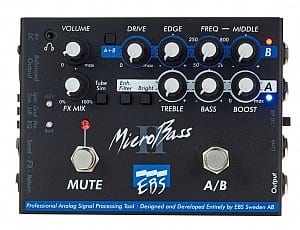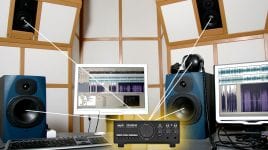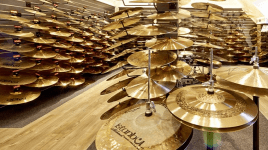
You’ve already purchased your bass, and perhaps you’ve even already formed a band of like-minded people. Now only one thing is missing: a bass amplifier to match! But which amp is the right one for you? How many watts do you need? And since we’re on the subject: which speakers should you choose to complete your setup? Don’t worry, we’re here to help 😉
Tube vs Transistor … or both
Tube amps
For a long time tube amps were reigned supreme and unchallenged in the world of amps, but those days are long gone! Although many tube heads such as the Ampeg SVT CL or the Orange AD200B Mk3, bring a special warmth to the sound, which is caused by the “harmonic distortion” thanks to tube technology, there are unfortunately also disadvantages. Pure tube heads are relatively maintenance-intensive and sensitive to external forces – such as a bumpy tour bus for instance! In addition, these type of amps are fairly heavy and large. Those who transport their own equipment, should decide whether they can live with this or should find a compromise. There are, however, still quite a few bassists who would never trade their tube amp for anything else!
Transistor amps
The first thing you may notice is their weight … they’re so light. Especially modern versions with a Class-D power amplifier, such as Eich Amplification T300, Markbass Little Mark Ninja, Aguilar Tone Hammer 500 or TC Electronic BH250 also save in space. Some of these amp heads can even fit inside the front pocket of a gig bag, which is ideal for many bassists who transport their own equipment –not only by car or tour bus, but also by plane!
Hybrid amps
Hybrid amps, such as EBS Fafner II, Markbass TTE 501, Markbass Little Mark Tube or Hartke LH-1000 combine a tube preamp with a transistor power amp. The advantages are obvious: low weight, and the neutrality of transistors combined with a warm tube sound. Where transistor amps from previous generations were once too sterile for the taste of many bassists, today’s representatives are well capable of offering rock and metal bassists that “loud and dirty” sound.
2 channel amps
So the next song needs a nice clean sound for the intro and a distorted sound later on, no problem! – Amplifiers with two-channels have one channel for clean sound and the other for distortion, and these can either be used independently or combined. Amplifiers such as Darkglass microtubes 900, the Orange OB1-500 or Gallien Krueger MB800 are incredibly versatile due to their two channels, which allows for precise interventions to the sound. Furthermore you can often switch between these channels (by footswitch) between or during songs!
Modeling amps
Still can’t decide between a vintage amp or a modern one? Modeling bass amps have the ability to faithfully “model” a variety of amps. If you need a lot of different sounds in one amp and you’re not shy from the somewhat steeper learning curve, then a modeling amp like the Markbass Bass Multiamp is the solution for you.
Do all tube amps or transistor amp heads sound the same?
Frankly, no! Despite structural similarities, we can safely say that each manufacturer more or less has its own sound. Nevertheless, it should be noted that: manufacturers such as Ampeg or Orange have established themselves in the world of bass amps thanks to their recognizable sound. Other manufacturers such as Glockenklang instead have chosen to reproduce the bass signal in the purest and transparent manner possible.
How many watts / performance power do I need?
Tube power and transistor power are not equal! In the world of tube amps, 100-200 watts of power is huge! The reason for this is the already mentioned harmonic tube distortion, the signal may appear “thicker” and “more powerful” than transistor amps of the same power. In the world of transistor amps, lower than 350 watts may not even be enough for a larger stage or a loud band.
It is not unusual for Modern Class-D amplifiers to have more than 1000 watts of power. Even if never fully extended, this power in reserve, referred to as “headroom” allows for excellent dynamics even at lower volumes. In this case, the more power, the better!
The neutrality of transistor amps have an advantage: it allows you to play all styles without much color. Bassists that play in multiple groups or styles will be therefore able to do so adequately. And with a minimum power of 350 Watt, you can play anywhere. Do beware, however, on bigger stages it is advisable to use stage monitor systems, this will allow musicians to hear each other better. Don’t worry about the crowd, the PA will take care of that!
Speakers
As with amplifiers, the market for speakers also continues to grow, with plenty of choice for all styles, tastes and budgets.
10-inch speakers
10″ speakers are the most popular size in the world of electric bass. They are fast in reproducing the bass signal and are therefore suitable for modern playing techniques such as slapping, tapping, or aggressive plucking.
However, speakers of this size are naturally limited in the reproduction of low bass frequencies. For this reason, manufacturers include more than one 10″ speaker (for e.g. two or four) in a cabinet. The membrane surfaces can add up this way, allowing more air to be moved. Since this inevitably increases the weight of the cabinet, nowadays many manufacturers use speakers with ultralight neodymium magnets, such as the Markbass Standard 104HF, the Glockenklang Take Five Neo and Hartke HX410 HyDrive!
15-inch speakers
To win your audience with a deep bass sound, it is often necessary to use larger speakers. With 18” speakers becoming extinct, 15” speakers have a high sound pressure while maintaining low distortion, such as the Harley Benton BB115T, Ashdown Toneman Deep 115 or Mesa Boogie Subway Ultra-Lite 1X15.
Stacks / Combinations
On the other hand, 15” speakers are not as fast as 10-inchers, which is why many bass players combine a 4 x 10-cabinet with a 1 x 15-cabinet. The result: “best of both worlds!” This speaker combination has been considered to be “the” classic stack for several decades. Despite its enormous weight and size, the results in sound is totally worth it.
Note: you can, of course, also combine other types of cabinets as well – anything goes. Be sure, however, to check the appropriate power and impedance specifications of different gear in order to prevent equipment damage!
Second note: speaker sizes vary from manufacturer to manufacturer, and often may not stack properly unless from the same manufacturer (for example with the aid of stacking-corners to prevent slippage!) So always check before purchase if the cabinets are actually compatible!
12-inch speaker
A 12″ speaker is a good compromise. Good sound pressure, transient speed and bass definition. The 12” is often overlooked because it does not deliver as low a frequency as a 15″, but you may find it to match your music better stylistically. Lend an ear to a Gallien Krueger NEO212-II-8 or Orange OBC212, and you might be amazed!
Monitoring In-Ear – with or without?
Many bass players rely on In-Ear Monitoring (IEM) systems to monitor their sound on stage. Although the sound performance is not comparable to a stack, its benefits (in terms of hearing preservation, sound separation and a clearer audio) are countless. Moreover, they are portable, lightweight and effective, and you won’t need to carry an entire stack. In-Ear Monitoring may require a period of adjustment at first and it may seem strange to be so “isolated” from others, but your ears will thank you!
A meatier sound with external preamps!
Often when bass players are connected directly (or through active DI Box) to the mixer, the sound of the instrument is said to be “too clean”, thin and almost boring. External preamps are an excellent remedy and placed between the bass and the mixer. Products like Darkglass microtubes B7K Ultra, Radial Engineering Bassbone V2, EBS Micro Bass II or Ampeg SCR-DI fulfill this task brilliantly. Caution: as with amplifiers, some preamps are more or less colored in tone. This is down to personal taste!
2 comments
Leave a Reply
You are currently viewing a placeholder content from Facebook. To access the actual content, click the button below. Please note that doing so will share data with third-party providers.
More InformationYou are currently viewing a placeholder content from Instagram. To access the actual content, click the button below. Please note that doing so will share data with third-party providers.
More InformationYou are currently viewing a placeholder content from X. To access the actual content, click the button below. Please note that doing so will share data with third-party providers.
More Information






















Henrik Ehrbahn says:
Kanon artikel alt er der taget højde for.
Larry says:
tak Henrik!